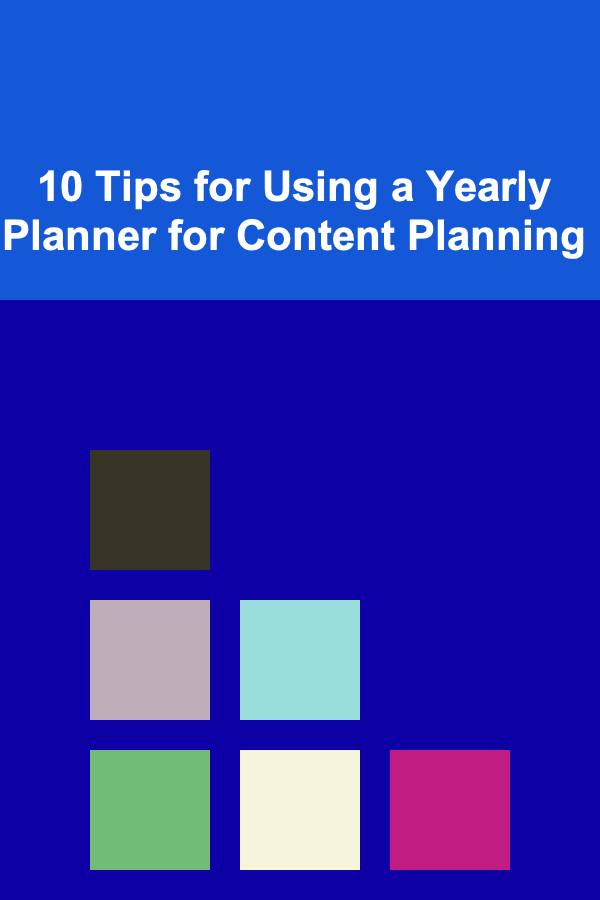
10 Tips for Using a Yearly Planner for Content Planning
ebook include PDF & Audio bundle (Micro Guide)
$12.99$9.99
Limited Time Offer! Order within the next:

Content planning is a critical part of any content creation process, whether for blogs, social media, podcasts, or other media. A well-structured content plan ensures consistency, maximizes your efforts, and keeps you on track toward achieving your goals. One of the best tools for content planning is a yearly planner. A yearly planner offers a bird's eye view of the entire year, enabling you to see the big picture while also allowing you to focus on the daily and monthly tasks. Here are 10 tips for effectively using a yearly planner to streamline your content creation process.
Start by Defining Your Annual Content Goals
Before you dive into planning content for each month, it's important to clearly define your annual goals. These goals will serve as the foundation for everything you do and will help ensure your content efforts align with your broader business or personal objectives.
Why It Matters:
Setting clear goals will give you a sense of direction and purpose for the year ahead. Whether your goal is to increase website traffic, grow your email list, or establish thought leadership in your industry, knowing what you want to achieve will guide the content you produce.
Tip:
Use the SMART goal framework (Specific, Measurable, Achievable, Relevant, Time-bound) to set clear, actionable content goals. For instance, "Increase blog traffic by 25% by the end of the year" is a specific and measurable goal that can be tracked.
Identify Key Dates and Events
A yearly planner allows you to visually track key dates and events such as product launches, holidays, industry conferences, or awareness months relevant to your audience. Mark these dates on your planner so you can align your content strategy with these events.
Why It Matters:
Timely content creation is crucial for relevance. Content tied to specific dates, such as holiday-related posts, product releases, or special promotions, can increase engagement and drive conversions. Planning ahead allows you to prepare content well in advance and avoid scrambling at the last minute.
Tip:
Create a content calendar in your yearly planner that highlights significant dates. You can also incorporate recurring events such as quarterly check-ins or annual reviews. This gives you a roadmap to follow when planning your content.
Break Down Your Goals into Quarterly Milestones
A yearly planner can be overwhelming when viewed all at once, which is why it's helpful to break down your annual goals into manageable chunks. Divide the year into quarters and set specific content milestones for each quarter. This will allow you to monitor your progress and adjust your strategy as needed.
Why It Matters:
Quarterly milestones help to create a sense of urgency and focus. Breaking down large goals into smaller, quarterly tasks makes the work feel more achievable and ensures that you're always moving forward toward your annual goals.
Tip:
Set quarterly themes or focus areas that align with your broader goals. For example, if your annual goal is to increase brand awareness, your first quarter might focus on increasing visibility through social media campaigns and influencer partnerships.
Plan Your Content Types and Formats
Content isn't just about what you say, but also how you say it. Use your yearly planner to decide on the types of content you'll create throughout the year. This could include blogs, social media posts, podcasts, videos, webinars, eBooks, newsletters, etc. Diversifying your content formats helps keep things fresh and engages different types of audiences.
Why It Matters:
Different content formats cater to different audience preferences. By planning a variety of content types, you'll be able to appeal to a wider audience and prevent your content from feeling monotonous.
Tip:
In your yearly planner, allocate months or quarters for different types of content. For instance, you might dedicate a particular quarter to video production or focus on written content in another. By doing this, you create a balanced content strategy that touches on all types of content formats.
Use Your Planner for Daily, Weekly, and Monthly Scheduling
While it's important to focus on the big picture, it's just as crucial to break your content plan down into manageable tasks. Use your yearly planner to create specific daily, weekly, and monthly content schedules. This will keep you organized and ensure that you consistently meet deadlines and milestones.
Why It Matters:
Breaking down tasks into daily or weekly actions prevents procrastination and helps you avoid feeling overwhelmed. It also allows you to stay consistent and track the smaller steps you're taking toward achieving your larger goals.
Tip:
Incorporate a weekly or monthly "content review" session in your planner. During this time, reflect on what's working, what isn't, and make adjustments accordingly. Being flexible with your plan ensures that you stay on track despite any unexpected challenges.
Plan for Seasonal Content
Certain topics are bound to be more relevant during certain seasons or months. For example, back-to-school content in August, summer vacation tips in June, or holiday-themed content in December. Use your yearly planner to identify which seasonal topics will resonate most with your audience and plan your content accordingly.
Why It Matters:
Seasonal content is often highly engaging because it taps into timely conversations. When you plan ahead, you can ensure your content aligns with the seasonal interests and needs of your audience.
Tip:
Create a "seasonal content" section in your yearly planner. This will allow you to brainstorm ideas for specific times of the year and get started early, ensuring that you're not rushing to create content at the last minute.
Incorporate Collaboration and Guest Contributions
If you plan on collaborating with others or featuring guest content (such as interviews, guest blog posts, or co-hosted webinars), the yearly planner is the perfect place to track these partnerships. This allows you to plan ahead and stay on top of your collaborative content efforts.
Why It Matters:
Collaboration can help expand your reach, bring fresh perspectives to your content, and increase audience engagement. Planning for collaborations early ensures that you have the time to organize and coordinate with your partners.
Tip:
In your planner, make a note of upcoming collaborations and set deadlines for each stage of the process, including outreach, content creation, and promotion. This helps to ensure that everything runs smoothly and on time.
Track Performance and Adjust Your Plan
A yearly planner isn't just for content creation; it can also serve as a tool for tracking your content's performance throughout the year. Mark key performance indicators (KPIs) on your planner, such as traffic, social media engagement, or lead generation, and track them regularly.
Why It Matters:
Regularly reviewing your performance helps you understand what's working and what needs improvement. It also provides insight into areas where you may need to pivot or update your content strategy.
Tip:
Schedule regular performance review meetings with your team (or set personal check-ins if you're working solo). Use these reviews to reflect on past content, adjust your goals, and plan new content based on data-driven insights.
Plan for Content Repurposing
Don't be afraid to repurpose existing content. In your planner, note down ideas for turning blog posts into social media updates, videos into blog posts, or podcast episodes into written summaries. Repurposing content is a smart way to extend the life of your content and maximize your ROI.
Why It Matters:
Content repurposing saves time and ensures that you get the most out of your content. Instead of constantly starting from scratch, you can create multiple pieces of content from a single idea.
Tip:
Incorporate a "content repurposing" strategy in your yearly planner. For example, if you publish a blog post each month, think about how you can transform that content into social media posts, email newsletters, or even downloadable resources for your audience.
Stay Flexible and Adapt to New Trends
While planning ahead is essential, content creation requires flexibility. The digital landscape is ever-changing, and new trends, technologies, and audience needs emerge regularly. Your yearly planner should allow for flexibility so you can adjust your content strategy when necessary.
Why It Matters:
Being adaptable to changes in the content landscape ensures that your content stays relevant and engaging. Trends such as viral social media challenges or sudden shifts in public interest can be capitalized on when you're flexible with your planning.
Tip:
Reserve some space in your planner for "spontaneous content" that can be created in response to emerging trends. This allows you to stay current without feeling overly restricted by your pre-set content calendar.
Conclusion
Using a yearly planner for content planning is a game-changer for anyone serious about content creation. It helps you stay organized, ensures that you meet your goals, and enables you to track progress throughout the year. By defining your annual goals, breaking them into quarterly milestones, and incorporating flexibility into your planning, you can make the most of your content efforts. Keep experimenting, adapting, and refining your content strategy, and soon you'll see the benefits of a well-structured content plan.
Reading More From Our Other Websites
- [Personal Care Tips 101] How to Make Your Own Healthy Protein Bars at Home
- [Home Budget Decorating 101] How to Add Personality to Your Home with Budget-Friendly Accessories
- [Weaving Tip 101] From Looms to Shuttle: Modern Innovations in Weaving Equipment
- [Organization Tip 101] How to Use Mason Jars for Organizing Small School Items
- [Organization Tip 101] How to Organize Food Storage in a Shared Kitchen
- [Personal Care Tips 101] How to Create a Luxurious Shaving Routine with Shaving Cream
- [Home Renovating 101] How to Create an Open Floor Plan in a Small Home Renovation
- [Organization Tip 101] How to Organize a Family Calendar for Everyone's Activities
- [Home Holiday Decoration 101] How to Create a Holiday Display with DIY Craft Projects
- [Home Security 101] How to Manage Guest Access for Home Security

How Cutting Back on Eating Out Can Improve Your Health and Finances
Read More
How to Ensure Your Home's Foundation Remains Strong
Read More
How to Secure Your Containerized Applications
Read More
Step-by-Step Guide to Making DIY Pet Toys and Accessories Your Pet Will Enjoy
Read More
How to Track Tax Planning Changes and Updates
Read More
How to Track Commission Income as a Freelancer
Read MoreOther Products

How Cutting Back on Eating Out Can Improve Your Health and Finances
Read More
How to Ensure Your Home's Foundation Remains Strong
Read More
How to Secure Your Containerized Applications
Read More
Step-by-Step Guide to Making DIY Pet Toys and Accessories Your Pet Will Enjoy
Read More
How to Track Tax Planning Changes and Updates
Read More